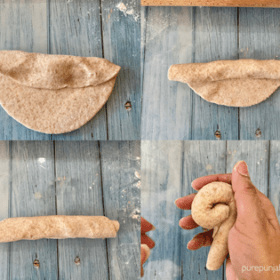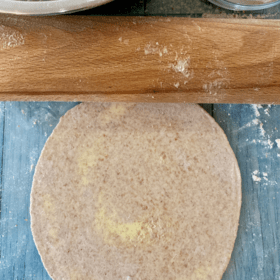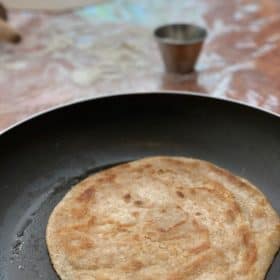Indian food
A step-by-step guide: How to make paratha from scratch
Paratha is the delicious crispy shallow-fried version of a roti, and is a very popular Punjabi bread.
The process starts out the same as making the roti, which is to make the atta (dough). However, butter is layered into the dough and rolled out, then shallow fried in ghee until light brown and crispy.
A step-by-step guide: How to make paratha from scratch
Follow steps 1-5 of the ‘How to make roti’ post – click HERE to get to this stage.
HOWEVER… only roll out to a SMALL sized roti
From here the process changes, as follows:
Step 6
Get a cold block of butter out of the fridge. Cut a couple of sticks of butter, and place them on the small disc of roti and then roll it up into a sausage shape. Try to keep the block of butter in a cool place away from the heat of the cooking, when you start to cook the paratha.

Step 7
Pre-heat a frying pan or tawa (ta-vah) on a low to medium heat.
Roll the sausage length into a coil, so that you are starting again with the process of making the small round of dough called a ‘pera’ (peh-rah). It’s important to overlap and press the coil together so that it doesn’t fall apart when rolling out again or separate when cooking!



Step 8
Start to roll out your pera, but as you roll it, the butter will start to press through the dough, so lightly flour, as needed. It may start to stick to the worktop or board, so it is ok to lightly push out into shape but keep it lightly floured. Unlike the roti, which must always be a perfect ROUND shape, the paratha can often be slightly square-ish. It should however, not be mis-shapen.
The paratha should be rolled out to the size of a large side plate. It can be slightly bigger than a standard size roti.

Step 9
Turn up the heat of your pan or tawa to a medium heat and melt a tablespoon of ghee in it. Ghee is always used to prevent excessive smoking and because it is suitable for frying/cooking at high heat. There will be a small amount of smoking from the butter inside the paratha.
Shallow fry, making sure the underside of the paratha is completely covered in ghee. When you see the colour change coming through the uncooked butter, place approximately a half-tablespoon of ghee on the top of the paratha and spread it across all sides and then carefully turn over, using a spatula, to fry the other side. Let this side fully fry to become brown and crispy, and then turn back over to finish the first side


Keep practicing and do share any pictures or videos of parathas that you’ve made, using the hashtag #PPCookerySchool
Good luck and enjoy making them!
Paratha is traditionally served with pickles, chutneys, sabjhi and is particularly delicious with Indian scrambled eggs.
To try out a sachet click HERE
Take a look at our Indian Bread-making Workshop & Tasting Experience, which teaches Paratha, Puri and Naan bread-making.


